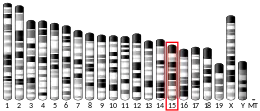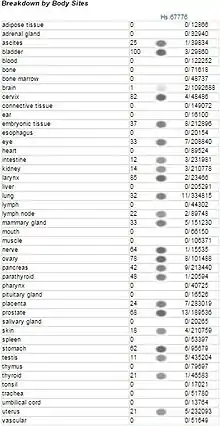FAM83H
FAM83H is a gene in humans that encodes a protein known as FAM83H (uncharacterized protein FAM83H). FAM83H is targeted for the nucleus and it predicted to play a role in the structural development and calcification of tooth enamel.
| FAM83H | |||||||||||||||||||||||||
|---|---|---|---|---|---|---|---|---|---|---|---|---|---|---|---|---|---|---|---|---|---|---|---|---|---|
| Identifiers | |||||||||||||||||||||||||
| Aliases | FAM83H, AI3, family with sequence similarity 83 member H, AI3A | ||||||||||||||||||||||||
| External IDs | OMIM: 611927 MGI: 2145900 HomoloGene: 15890 GeneCards: FAM83H | ||||||||||||||||||||||||
| |||||||||||||||||||||||||
| |||||||||||||||||||||||||
| |||||||||||||||||||||||||
| Orthologs | |||||||||||||||||||||||||
| Species | Human | Mouse | |||||||||||||||||||||||
| Entrez | |||||||||||||||||||||||||
| Ensembl | |||||||||||||||||||||||||
| UniProt | |||||||||||||||||||||||||
| RefSeq (mRNA) | |||||||||||||||||||||||||
| RefSeq (protein) | |||||||||||||||||||||||||
| Location (UCSC) | Chr 8: 143.72 – 143.74 Mb | Chr 15: 76 – 76.01 Mb | |||||||||||||||||||||||
| PubMed search | [3] | [4] | |||||||||||||||||||||||
| Wikidata | |||||||||||||||||||||||||
| |||||||||||||||||||||||||
Gene
Location
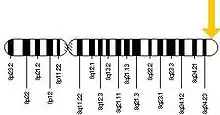
FAM83H is located on the long arm of chromosome 8 (8q24.3), starting at 143723933 and ending at 143738030. The FAM83H gene spans 14097 base pairs and is orientated on the—strand. The coding region is made up of 5,604 base pairs and 5 exons.[5]
Homology
Orthologs
Below is a table of a variety of orthologs of the human FAM83H. The table include closely, intermediately and distantly related orthologs.
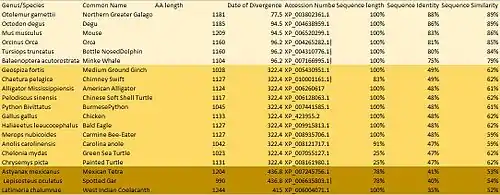
Orthologs of the human protein FAM83H are listed above in descending order or date of divergence and then ascending order of percent identity. FAM83H is highly conserved throughout all orthologs, this is demonstrated with a 40% identity in the least similar ortholog. FAM83H has evolved slowly and evenly over time.[12][13]
Protein
General Properties
The molecular weight of FAM83H is 127.1kD and contains 1179 amino acids. The isoelectric point is 6.52. There are no significant positive or negative charge clusters in the protein. There is a stretch of 21 0’s from 254-275 and a stretch of 24 0’s from 420-444.1 [14]
Composition
FAM83H is proline rich, being 10.32% protein, and is asparagine deficient with only 1.1%. The percent composition of each amino acid is fairly consistent throughout the orthologs of the protein. The most distant ortholog displays the most variance in amino acid composition.
Domains
FAM83H has two known domains. The PLDc_FAM83H (phospholipase like domain) domain stretches from 17-281 on FAM83H. It lacks the functionally important histidine, so while it may share similar structure it most likely lacks PLD activity. The MIP-T3 microtubule binding domain stretches from 909-1176.[15]
Post-translational modifications
FAM83H is highly phosphorylated post modification. There are 11 predicted phosphorylated sites. There are two motifs with high probability of post translational modification sumoylation sites. Sumoylation sites are involved in a number of cellular processes, including nuclear-cytosolic transport, transcriptional regulation and protein stability. FAM83H does not have a signal peptide

Secondary Structure
Fam83H is primarily composed of alpha helices and random coils. Alpha helices comprise the majority of the protein. There is a transmembrane domain from 231-252.[16][17]
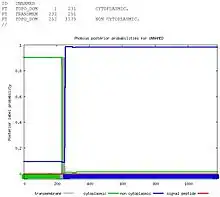
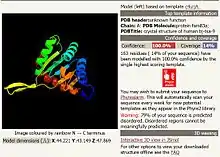
Interacting Proteins
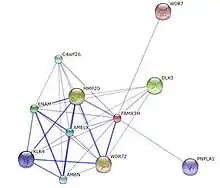
FAM83H was found to interact with WDR72 and MMP20.[19] MMP20 is responsible for the breakdown of extracellular matrix and plays a role in tissue remodeling in ameloblasts. mutations in WDR72 is thought to play a role in amelogenesis imperfecta
Clinical Significance
References
- ENSG00000273889 GRCh38: Ensembl release 89: ENSG00000180921, ENSG00000273889 - Ensembl, May 2017
- GRCm38: Ensembl release 89: ENSMUSG00000046761 - Ensembl, May 2017
- "Human PubMed Reference:". National Center for Biotechnology Information, U.S. National Library of Medicine.
- "Mouse PubMed Reference:". National Center for Biotechnology Information, U.S. National Library of Medicine.
- "NCBI gene database". NCBI.
- "GEO profiles". NCBI geo profiles.
- "EST profiles". NCBI EST profiles.
- "Emsembl". Vega.
- "Genecards". The Gene Human Database.
- "Aceview". NCBI.
- "Genecards". The Gene Human Database.
- "BLAST". NCBI.
- Hedges, SB. "TimeTree". Bioinformatics.
- "SAPS". Statistical Analysis of Protein Sequence, Biology Workbench.
- "NCBI Structure". The Gene Human Database.
- "PELE". San Diego Supercomputer Center.
- "CHOFAS (Predict Secondary Structure of PS". Chou-Fasman. Archived from the original on 2003-08-11. Retrieved 2015-05-09.
- "PSORT II". Expasy.
- "IntAct". EMNL-EBI.
- "NCBI gene database". NCBI.
- "Genecards". The Gene Human Database.
Further reading
- Kim JW, Lee SK, Lee ZH, et al. (2008). "FAM83H mutations in families with autosomal-dominant hypocalcified amelogenesis imperfecta". Am. J. Hum. Genet. 82 (2): 489–94. doi:10.1016/j.ajhg.2007.09.020. PMC 2427219. PMID 18252228.
- Ding Y, Estrella MR, Hu YY, et al. (2009). "Fam83h is associated with intracellular vesicles and ADHCAI". J. Dent. Res. 88 (11): 991–6. doi:10.1177/0022034509349454. PMC 2835506. PMID 19828885.
- Hart PS, Becerik S, Cogulu D, et al. (2009). "Novel FAM83H mutations in Turkish families with autosomal dominant hypocalcified amelogenesis imperfecta". Clin. Genet. 75 (4): 401–4. doi:10.1111/j.1399-0004.2008.01112.x. PMC 4264522. PMID 19220331.
- Bonaldo MF, Lennon G, Soares MB (1996). "Normalization and subtraction: two approaches to facilitate gene discovery". Genome Res. 6 (9): 791–806. doi:10.1101/gr.6.9.791. PMID 8889548.
- Lee SK, Hu JC, Bartlett JD, et al. (2008). "Mutational spectrum of FAM83H: the C-terminal portion is required for tooth enamel calcification". Hum. Mutat. 29 (8): E95–9. doi:10.1002/humu.20789. PMC 2889227. PMID 18484629.
- El-Sayed W, Shore RC, Parry DA, et al. (2010). "Ultrastructural analyses of deciduous teeth affected by hypocalcified amelogenesis imperfecta from a family with a novel Y458X FAM83H nonsense mutation". Cells Tissues Organs (Print). 191 (3): 235–9. doi:10.1159/000252801. PMC 4432877. PMID 20160442.
- Strausberg RL, Feingold EA, Grouse LH, et al. (2002). "Generation and initial analysis of more than 15,000 full-length human and mouse cDNA sequences". Proc. Natl. Acad. Sci. U.S.A. 99 (26): 16899–903. doi:10.1073/pnas.242603899. PMC 139241. PMID 12477932.
- Brandenberger R, Wei H, Zhang S, et al. (2004). "Transcriptome characterization elucidates signaling networks that control human ES cell growth and differentiation". Nat. Biotechnol. 22 (6): 707–16. doi:10.1038/nbt971. PMID 15146197. S2CID 27764390.
- Wright JT, Frazier-Bowers S, Simmons D, et al. (2009). "Phenotypic variation in FAM83H-associated amelogenesis imperfecta". J. Dent. Res. 88 (4): 356–60. doi:10.1177/0022034509333822. PMC 2754853. PMID 19407157.
- Hyun HK, Lee SK, Lee KE, et al. (2009). "Identification of a novel FAM83H mutation and microhardness of an affected molar in autosomal dominant hypocalcified amelogenesis imperfecta". Int Endod J. 42 (11): 1039–43. doi:10.1111/j.1365-2591.2009.01617.x. PMID 19825039.


